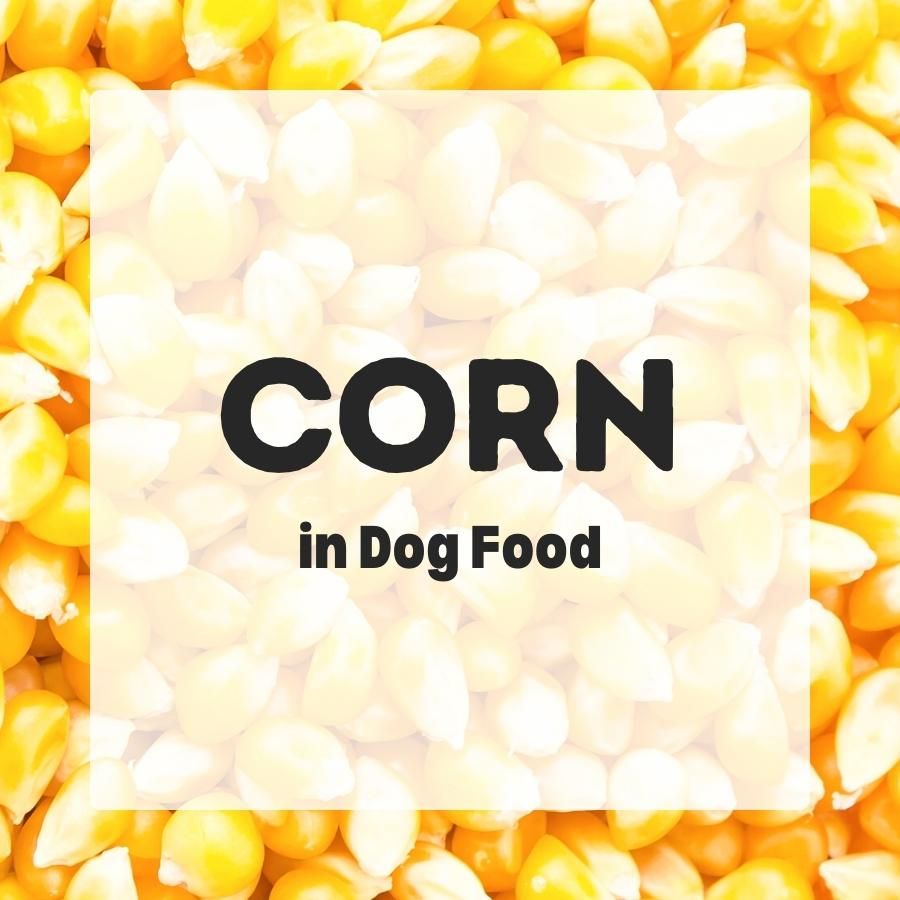Corn in dog food provides energy, nutrients and texture. But corn is not only the most widely used but also one of the most controversial ingredients in pet food.
Contents
About Corn
Corn (Zea mays) is the largest of the cereal grains.
It is also the most produced grain worldwide both as a worldwide staple food and for many non-food products.
Pet food manufacturers need to include certain amounts of starch in their recipes because it is vital for the processing of dry extruded kibble. And corn is widely available in the US.
A perfect match, right?
Every year, pet food manufacturers use over 990,000 tons of corn in their products, making it the leading ingredient in dog food[2,4].
Corn […] is the largest ingredient compared with all food ingredients for dog food products.
Pet Food Production and Ingredient Analysis 2020[2]
There are different cultivars of corn. While sugary sweet corn or popcorn is directly grown as food, field corn is more starchy.
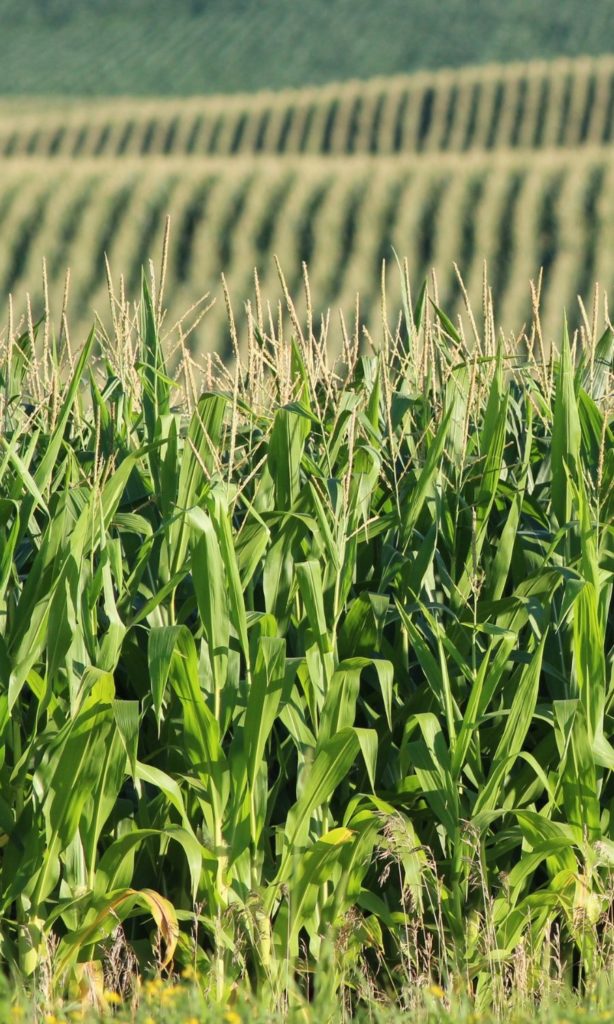
Field corn is used as a source of energy in livestock nutrition.
Some field corn goes directly into foods such as flakes, flour, hominy, and grits. But most of it is processed for starch, sugar, syrup, corn oil, and corn gluten meal, and it is the main raw material for ethanol production[13].
Corn in dog food is mainly used because it is well-studied and inexpensive. Its starch content provides texture and energy.
Whole corn kernels can also provide other nutrients such as fiber, protein, vitamins, minerals, and fatty acids. Additionally, many by-products of corn processing are included in pet food.
But corn is also one of the most controversial ingredients, viewed by many pet lovers as an inferior “filler” or allergen[22].
Additionally, since the 1990s, most of the corn grown in the US is genetically modified. And the environmental impact of GMO corn is a complex issue and part of an ongoing debate.
Whole Grain Corn
Whole corn kernels can be divided into three parts:
- The corn endosperm is the large starchy part of the kernel, it contains protein and lots of storage carbohydrates.
- The corn bran includes the pericarp (hull) and the protective fiber layers (lignin, cellulose, hemicellulose, and pectin).
- The corn germ is the embryonic tissue that contains high amounts of lipids, micronutrients, and protein. It can be easily separated during processing and be used for oil extraction.
Whole grain corn in dog food includes all of these parts, bran, germ, and endosperm.
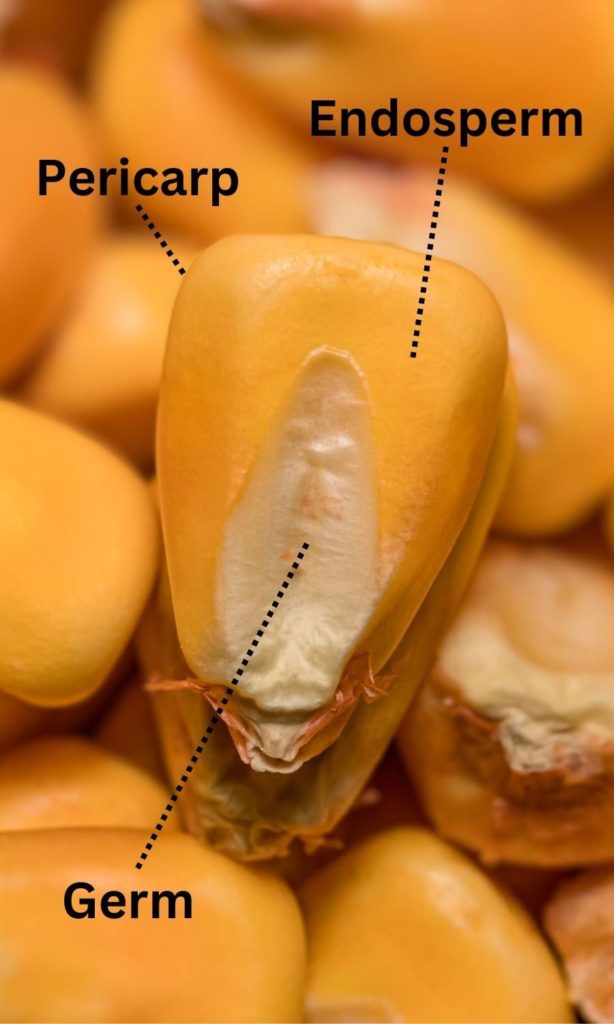
Obviously, dog foods don’t use whole intact kernels, during processing corn gets ground into corn meal/corn flour.
Ground whole corn is mainly a source of highly digestible starch, it also provides some fat, protein, fiber, and micronutrients[7,21].
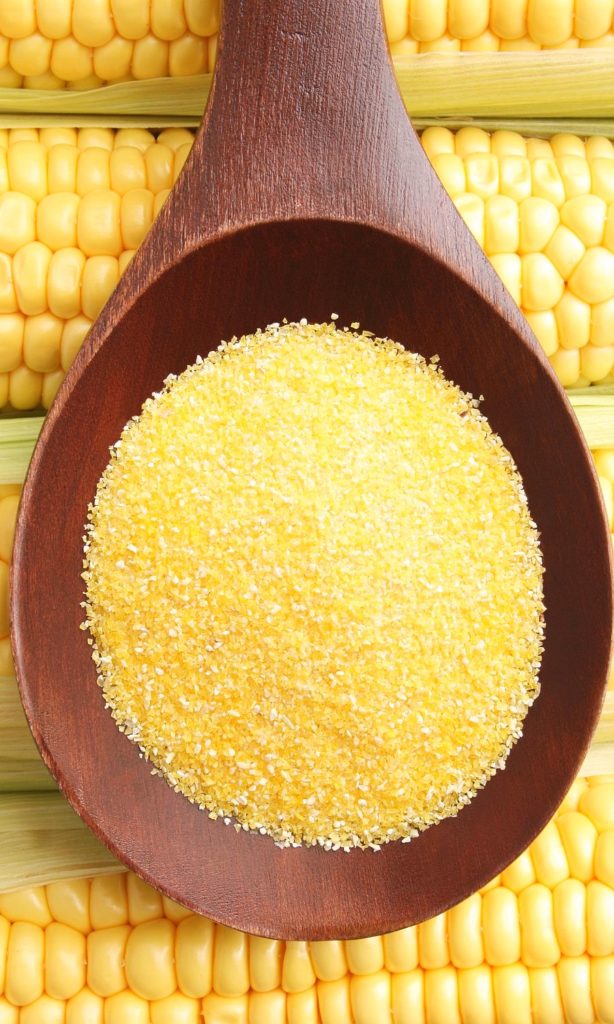
Cooked starch from corn flour is highly digestible[6,11].
The major storage protein in corn is called zein, followed by glutelin, they are found mainly in the endosperm and germ. Unfortunately, zein is deficient in lysine and tryptophan, two essential amino acids.
Yellow corn varieties provide some beta-carotene and xanthophylls.
But whole grain corn provides less protein compared to other whole grains. It is also higher in fiber which can add more bulk to your dog’s output[5].
The nutrient composition of whole corn can vary greatly depending on origin, variety, processing method, etc.
| Whole Corn[5] | Corn Flour[7] | Pet Food Corn[3] | |
|---|---|---|---|
| Protein | 7.1% | 11.2% | 9.8% |
| Fiber | 13.5% | 2.8% | 10.8% |
| Fat | 5.1% | 2.6% | 6% |
| Starch | 65.0% | 84.3% | 77.2% |
Corn Starch
This is the concentrated starch obtained from corn endosperms. Corn starch in dog food is used to add carbs and texture.
It is very high in rapidly digestible starch[7]. And highly digestible starches cause a more immediate glucose and insulin response.[23].
Even a 2022 corn industry-funded study on the value of corn in pet foods admitted that controlling glucose absorption in rapidly digested corn-based diets should be addressed[3].
It is the primary product of corn wet milling. Starch extraction produces lots of by-products later recycled into feed ingredients.
Corn starch can be further processed into other corn ingredients such as high-fructose corn syrup or modified corn starch.
Modified corn starch has been chemically altered to be used as a food additive, e.g. as a binder and thickener in wet dog food.
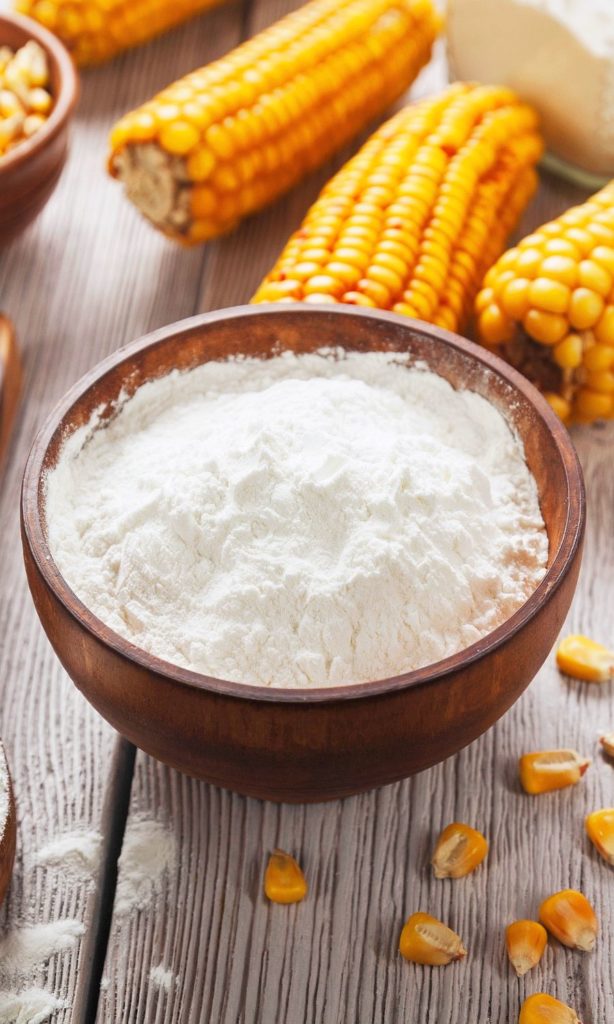
Corn Gluten Meal
This is a by-product of corn starch processing obtained after most of the starch, bran and germ are removed.
What’s left is corn gluten meal, a highly digestible protein ingredient.
A 2004 study examined the feeding value of corn gluten meal to dogs when included in increasing amounts in a complete food[26].
As the amount of corn gluten meal in the food increased, the dogs produced more output with higher moisture levels.
Also, the overall digestibility of dry matter decreased slightly.
However, the ileal digestibility of crude protein increased with more corn gluten meal in the food. Of all amino acids, methionine had the highest overall ileal digestibility and threonine the lowest.
The researchers concluded that corn gluten meal in dog foods can be a highly digestible protein source when used in the right amounts.
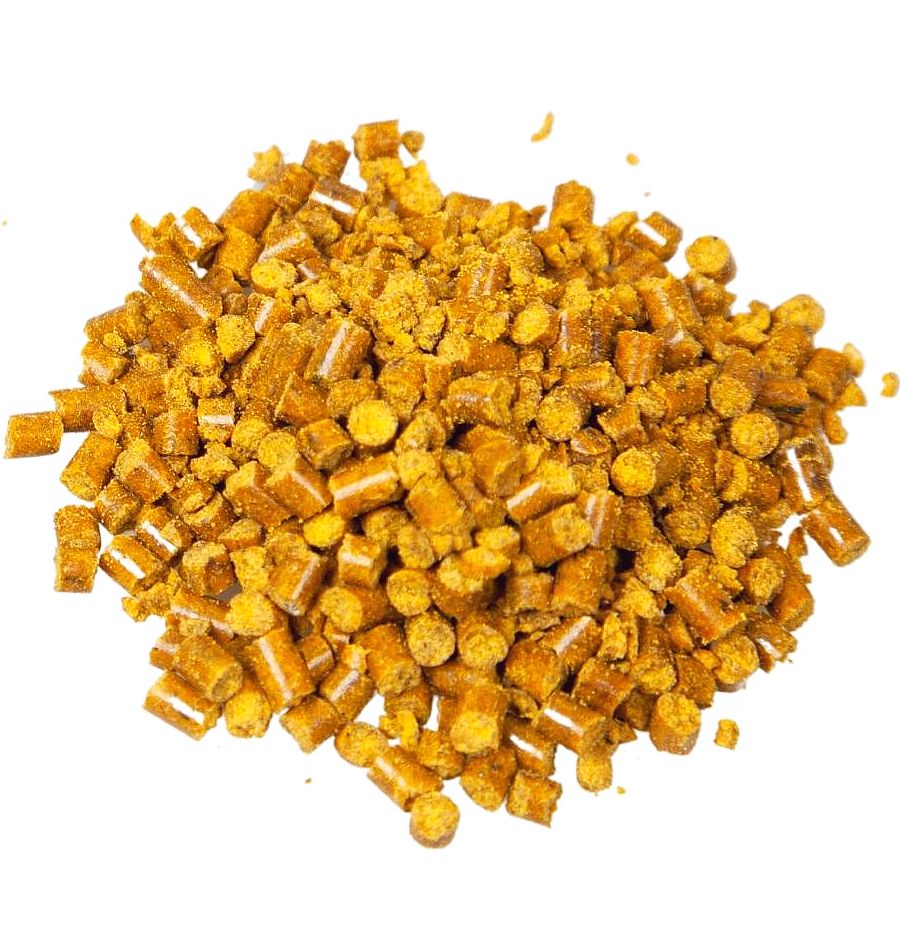
Corn gluten meal contains about 60-75% crude protein and 15-20% of residual starch in dry matter, with small amounts of fiber, fat, and minerals[21].
It has a good methionine content but is low in lysine and tryptophan[5,20,21]. Overall, it has an unbalanced amino acid profile and has to be supplemented with complementary proteins or amino acids.
For this reason, it is often combined with soy products to balance out deficiencies in essential amino acids[13].
By the way, its name is kind of misleading since corn does not contain functional gluten[3]. Calling it “corn gluten meal” instead of just “corn protein meal” simply has a tradition as an old industry term.
Corn gluten meal in dog food undeniably has some nutritional value as a source of amino acids. But it doesn’t provide a complete protein and it can be contaminated with mycotoxins[27].
| Nutrients In Dry Matter | Corn Gluten Meal[21] |
|---|---|
| Crude protein | 67.2% |
| Crude fiber | 1.2% |
| Crude fat | 2.9% |
| Ash | 2.1% |
| Starch | 17.6% |
| Sugars | 0.5% |
Corn Germ Meal
Corn germ meal is a by-product of oil extraction. Think of it as the leftovers of corn germs after the oil has been removed chemically or mechanically.
Corn germ meal in dog food is a low-cost ingredient with a very variable composition since it can have varying portions of protein, oil, fiber and starch.
| Nutrients In Dry Matter | Corn Germ Meal[21] |
|---|---|
| Crude protein | 10-30% |
| Crude fiber | 6-10% |
| Crude fat | 1-20% |
| Ash | 2-6% |
| Starch | 22-37% |
| Sugars | 1-7% |
Corn Oil
To produce corn starch or glucose, one of the first steps of processing is to remove the corn germ.
The corn germ contains about 45-50% of oil which can be extracted with chemical solvents or by mechanical pressure.
Corn oil in dog food is a low-cost ingredient very rich in inflammatory omega-6 fatty acids. But it also contains phytosterols and some vitamin E.
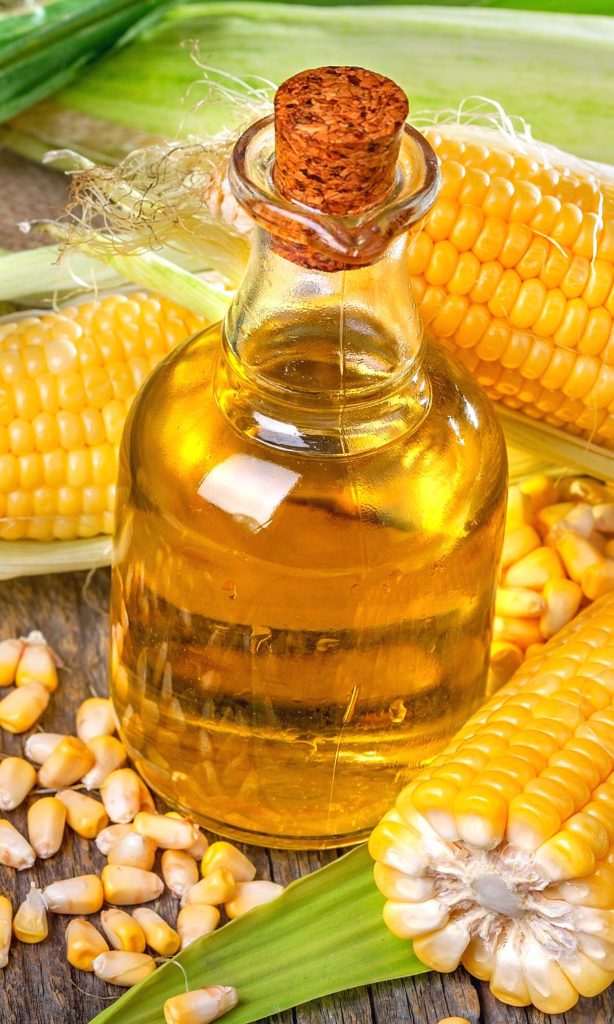
Corn oil is just as digestible as poultry fat for dogs and can be used as a source of flavor and energy in dog food[14].
But overall, it is not considered a healthy fat since it is a highly refined vegetable oil and may produce harmful acrylamide when heated.
Corn Syrup
This is a dextrose syrup obtained from corn starch.
Small amounts used in dog food are probably fine. It still remains a questionable ingredient.
Standard corn syrup in dog food is used as a flavor enhancer, sweetener, thickener, or humectant to maintain moisture and texture.
Like any added sugar, in excess, it can contribute to health problems such as weight gain, diabetes, and other metabolic issues.
But there are refined types of corn syrup:
High Fructose Corn Syrup
High-fructose corn syrup is produced enzymatically from corn starch. It is used as a low-cost sweetener because it contains a lot of fructose and glucose.
Fructose is the sweetest natural sugar but was virtually absent in our diet a few hundred years ago. But today it is common in many products thanks to its sweetening strength and low cost[25].
It is found in sucrose from ingredients such as beet or cane sugar, fruits, honey or commercially produced high-fructose corn syrup.
Fructose has the same chemical formula as glucose but is metabolized more rapidly in the liver into glucose, glycogen, lactate, and fat[24].
However, too much fructose can be just as bad for dogs as it is for us. It can cause digestive upset and tooth decay.
Long-term exposure may lead to metabolic issues like insulin resistance, obesity, and high blood pressure[24,25].
Hydrogenated Corn Syrup
Hydrogenated corn syrup is made from corn syrup that has been treated with hydrogen gas. The gas reacts with the unsaturated bonds in the corn syrup, causing them to become saturated.
This produces a more stable and solid form of corn syrup.
It is a solidified sweetener and approved as a food additive to be used as a humectant and plasticizer in semi-moist dog foods.
Other Corn Ingredients
Of course, there are also other minor by-products of starch milling that some pet food businesses feel the need to use in dog food:
Corn protein concentrate is the concentrated protein fraction of corn endosperms extracted from the leftovers of starch wet milling.
Corn protein is highly digestible and can be used as a cost-effective source of cereal-sourced amino acids in dog food.
Corn distiller’s dried grains with solubles are a by-product derived after dry-milling and the industrial fermentation and distillation of corn for ethanol or biofuel production.
Although this ingredient is rich in protein, unsaturated fatty acids, and other nutrients, it is more common for pig feed than dog food.
Corn gluten feed varies greatly in composition since it is a mixture of by-products such as bran, fermented corn extractives/steep liquor, or corn germ meal.
Overall, it’s used in dog foods as an inexpensive source of protein, residual starch, fiber, and some minerals.
It is nutritionally completely different from corn gluten meal and contains way less protein. It is also less digestible[9].
Hominy feed in dog food is used as a substitute for corn. It is mostly high in starch and fiber with some fat and minerals.
It is a high-energy by-product of corn milling and consists of varying compositions of corn bran, germ, and starchy parts such as broken kernels.
Is Corn Bad For Dogs?
First of all, pet food businesses can choose from very many different corn ingredients with different qualities and purposes.
But the excessive use of corn as a low-cost ingredient has made it quite unpopular among dog owners.
And with the rise of the grain-free movement, corn as the most popular grain in pet foods became also the most criticized.

One point of concern is that corn might cause allergies.
Overall, food allergies in dogs are overall rare. And grains account for less than 1.5% of all food allergy cases[17].
While almost any protein can cause an allergy, most affected dogs react to animal proteins[16]. Usually, the proteins that cause the most problems are typically the ones that are most widely used.
But although corn is so widely used the most likely food allergens for dogs are beef, dairy products, chicken, and wheat[16].
That still doesn’t make any of them “bad ingredients“. It just reflects how insanely many dogs are exposed to these ingredients.
So: The chances for your dog’s immune system to falsely recognize boring old corn as an allergen are just slightly greater if you feed a dog food made with corn each and every day.
But this is more a question of the current little diversified feeding practices than of good versus bad ingredients.
Also, many dogs with allergies actually react to the storage mites that are in and on the food. And this is more of a “kibble problem“.
Critics of corn in dog food also claim that is just an inexpensive and poorly digestible “filler” with low nutritional value.
Corn fiber is quite high in insoluble compounds such as cellulose, hemicellulose, and lignin. This promotes gut motility but adds a little more volume to your dog’s output.
But it is more than just empty fibers, corn in dog food can add lots of digestible nutrients such as carbohydrates, protein, and fat.
Corn seems to be a little less effectively utilized than rice[11,15]. However, different corn ingredients have been shown to be digestible by dogs[3].
Like many plant ingredients, corn is susceptible to various molds and can be contaminated with aflatoxins[12,21].
And if you don’t want genetically modified ingredients in your dog’s food it’s probably a good call to avoid corn.
But as a source of starch, it is no worse than other grains.
Being an inexpensive ingredient can help keep the cost of dog food down while still providing a sustainable and digestible source of energy.
But… some dog food manufacturers use excessive amounts of corn protein as a substitute for animal-sourced proteins.
While corn can provide lots of amino acids, it’s not a complete protein and not acceptable as a main source of protein.
One valid criticism is that while many kibble diets are extremely high in corn, some manufacturers highlight only the meat ingredients and make you hope and pay for more than you actually get.
In summary, corn shares many common problems with other grains and has a bad reputation among dog owners, in many cases based on anecdotal evidence or half-truths.
Corn is just more heavily demonized because it is so widely used and linked to cheap foods and corn syrup, I think. But to be fair, it has been used in pet foods for decades without causing major problems
But still, it is indeed a rather cheap ingredient used often in not-so-premium dog foods.
And manufacturers have long slept on their chance to promote its qualities to pet owners. Or to reassure pet owners that it’s ok to feed corn to their dogs (like with this 2022 study on corn in pet foods commissioned by Kansas Corn).
So it may take a while before corn makes its comeback as a well-tolerated dog food ingredient.
Corn is not bad for dogs. But it is also nothing special and often used in excessive amounts for mainly economic reasons.
But unless your dog is sensitive to corn, there is no need to avoid corn-inclusive foods when it is used in reasonable amounts.
Further Reading
[1] AAFCO Official Publication. Chapter 6. Free Access.
[2] Pet Food Production and Ingredient Analysis (PDF). 2020. Institute for Feed Education and Research (IFEEDER), North American Renderers Association (NARA), Pet Food Institute (PFI)
[3] Corsato Alvarenga et al. A review: nutrition and process attributes of corn in pet foods. Critical Reviews in Food Science and Nutrition. 2022. https://doi.org/10.1080/10408398.2021.1931020
[4] Schertz. Dog Food Production from Farm to Food Bowl: Evaluating FDA’s Regulatory Oversight and the Impact on Food Safety. Food Safety and Biosecurity. 2021. http://hdl.handle.net/10919/103224
[5] Beloshapka et al. Compositional Analysis of Whole Grains, Processed Grains, Grain Co-Products, and Other Carbohydrate Sources with Applicability to Pet Animal Nutrition. Foods. 2016. https://doi.org/10.3390/foods5020023
[6] Murray et al. Evaluation of selected high-starch flours as ingredients in canine diets. Journal of Animal Science.1999. https://doi.org/10.2527/1999.7782180x
[7] Bednar et al. Starch and Fiber Fractions in Selected Food and Feed Ingredients Affect Their Small Intestinal Digestibility and Fermentability and Their Large Bowel Fermentability In Vitro in a Canine Model. The Journal of Nutrition. 2001. https://doi.org/10.1093/jn/131.2.276
[8] Gajda et al. Corn hybrid affects in vitro and in vivo measures of nutrient digestibility in dogs. Journal of Animal Science. 2005. https://doi.org/10.2527/2005.831160x
[9] Kawauchi et al. Digestibility and metabolizable energy of maize gluten feed for dogs as measured by two different techniques. Animal Feed Science and Technology. 2011. https://doi.org/10.1016/j.anifeedsci.2011.05.005
[10] Zhuang et al. Purification and identification of antioxidant peptides from corn gluten meal. Journal of Functional Foods. 2013. https://doi.org/10.1016/j.jff.2013.08.013
[11] Twomey et al. The use of sorghum and corn as alternatives to rice in dog foods. The Journal of Nutrition. 2002. https://doi.org/10.1093/jn/132.6.1704S
[12] Sharma & Márquez. Determination of aflatoxins in domestic pet foods (dog and cat) using immunoaffinity column and HPLC. Animal Feed Science and Technology. 2001. https://doi.org/10.1016/S0377-8401(01)00274-7
[13] de Godoy et al. Select corn coproducts from the ethanol industry and their potential as ingredients in pet foods. Journal of Animal Science. 2009. https://doi.org/10.2527/jas.2007-0596
[14] Sabchuk et al. Crude corn oil as dietary fat source for dogs. Animal Feed Science and Technology. 2019. https://doi.org/10.1016/j.anifeedsci.2018.11.014
[15] Kore et al. Evaluation of alternative cereal sources in dog diets: Effect on nutrient utilization and hindgut fermentation characteristics. Journal of the Science of Food and Agriculture. 2009. https://doi.org/10.1002/jsfa.3698
[16] Mueller et al. Critically appraised topic on adverse food reactions of companion animals (2): common food allergen sources in dogs and cats. BMC Vet Res. 2016. https://doi.org/10.1186/s12917-016-0633-8
[17] Laflamme et al. Myths and misperceptions about ingredients used in commercial pet foods. Veterinary Clinics: Small Animal Practice. 2014. https://doi.org/10.1016/j.cvsm.2014.03.002
[18] Bazolli et al. Effect of the particle size of maize, rice, and sorghum in extruded diets for dogs on starch gelatinization, digestibility, and the fecal concentration of fermentation products. Journal of Animal Science. 2015. https://doi.org/10.2527/jas.2014-8409
[19] Kendall & Holme. Studies on the digestibility of soya bean products, cereals, cereal and plant by-products in diets of dogs. J Sci Food Agr. 1982. https://doi.org/10.1002/jsfa.2740330902
[20] Reilly et al. Use of the precision-fed cecectomized rooster assay to determine standardized amino acid digestibility, true metabolizable energy content, and digestible indispensable amino acid scores of plant-based protein by-products used in canine and feline diets. Translational Animal Science. 2021. https://doi.org/10.1093/tas/txab025
[21] Feedipedia.org – Animal Feed Resources Information System.
[22] Dog Food Advisor: The Truth About Corn in Dog Food.
[23] Carciofi et al. Effects of six carbohydrate sources on dog diet digestibility and post-prandial glucose and insulin response. J Anim Physiol Anim Nutr. https://doi.org/10.1111/j.1439-0396.2007.00794.x
[24] Saraiva et al. Natural Sweeteners: The Relevance of Food Naturalness for Consumers, Food Security Aspects, Sustainability and Health Impacts. Int J Environ Res Public Health. 2020. https://doi.org/10.3390%2Fijerph17176285
[25] Tappy & Le. Metabolic effects of fructose and the worldwide increase in obesity. Physiol. Rev. 2010. https://doi.org/10.1152/physrev.00019.2009
[26] Yamka et al. Evaluation of maize gluten meal as a protein source in canine foods. Animal Feed Science and Technology. 2004. https://doi.org/10.1016/j.anifeedsci.2004.06.007
[27] Geicu et al. Composition-Based Risk Estimation of Mycotoxins in Dry Dog Foods. Foods. 2023. https://doi.org/10.3390/foods12010110
